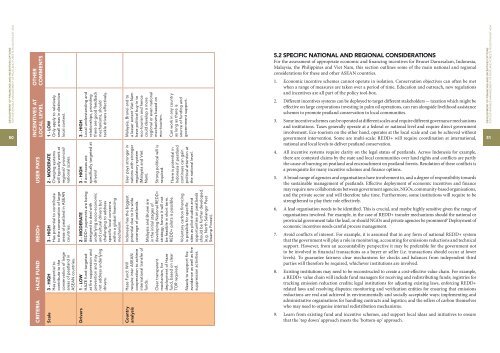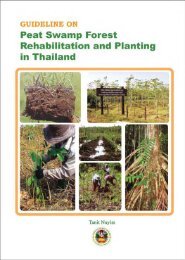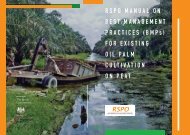Untitled - Peat Portal
Untitled - Peat Portal
Untitled - Peat Portal
You also want an ePaper? Increase the reach of your titles
YUMPU automatically turns print PDFs into web optimized ePapers that Google loves.
DEVELOPMENT OF FINANCING AND INCENTIVES OPTIONSFOR SUSTAINABLE MANAGEMENT OF PEATLAND FORESTS IN SOUTHEAST ASIA50OthERCOMMENTSINCENTIVES atLOCAL levelCRITERIA HAZE FUND REDD+ USER PAYS1 - LOWOnly apply to relativelysmall areas in distinctivelocal context.2 - MODERATECharging systemswill typically work atregional/ provincial/national scales.3 - HIGHHas potential to contributeto the conservation of largeareas of peatland in ASEANcountries.Scale 3 - HIGHHas potential tocontribute to theconservation of largeareas of peatland inASEAN countries.3 - HIGHLocal understanding andrelationships, providingthere are good feedbackmechanisms, shouldtackle drivers effectively.3 - HIGHIf eco-taxes arespecifically targeted atdrivers!2 - MODERATEREDD+ payments are beingdesigned to deal withunderlying socio-economicand cultural drivers butchallenging to addressspecific local concernswithin a global financingmechanism.Drivers 1 - LOWHAZE fund targetedat fire suppression andprevention and maynot address underlyingdrivers.Malaysia, Brunei and toa lesser extent Viet Namhave political buy-in toeco-tourism and hencecould develop a moreregional or even nationalmechanisms based oneco-tourism.User pays stronger innations with strongerregulatory system(Malaysia and VietNam).Indonesia has the biggestpotential due to its widecoverage of peatlands.Haze Fund: Willrequire inter ASEANcooperation to achieveinternational transfer offunds.CountryanalysisStrong political will isrequired.Malaysia and Brunei arein the initial stages ofdeveloping National REDD+strategy, hence it will notbe feasible in short term.REDD+ pilots is possible.Can work in any countryas long as there issource of funding andgovernment support.Clear transparentmechanism, fordeployment of Hazefund, based on clearTOR required.There is potential inIndonesia if peatlandcontinues can gainpolitical attention atthe national level.Voluntary carbon financingis possible for specificsites as pilot studies andopportunities on peatlandsshould be further developed.(e.g. North Selangor <strong>Peat</strong>Swamp Forest).Needs to support fireavoidance as well as firesuppression activities.5.2 SPECIFIC NATIONAL AND REGIONAL CONSIDERATIONSFor the assessment of appropriate economic and financing incentives for Brunei Darussalam, Indonesia,Malaysia, the Philippines and Viet Nam, this section outlines some of the main national and regionalconsiderations for these and other ASEAN countries.1. Economic incentive schemes cannot operate in isolation. Conservation objectives can often be metwhen a range of measures are taken over a period of time. Education and outreach, new regulationsand incentives are all part of the policy tool-box.2. Different incentives systems can be deployed to target different stakeholders - taxation which might beeffective on large corporations investing in palm oil operations, can run alongside livelihood assistanceschemes to promote peatland conservation in local communities.3. Some incentive schemes can be operated at different scales and require different governance mechanismsand institutions. Taxes generally operate at a federal or national level and require direct governmentinvolvement. Eco-tourism on the other hand, operates at the local scale and can be achieved withoutgovernment intervention. Some are multi-scale: REDD+ will require coordination at international,national and local levels to deliver peatland conservation.4. All incentive systems require clarity on the legal status of peatlands. Across Indonesia for example,there are contested claims by the state and local communities over land rights and conflicts are partlythe cause of burning on peatland and encroachment on peatland forests. Resolution of these conflicts isa prerequisite for many incentive schemes and finance options.5. A broad range of agencies and organisations have involvement in, and a degree of responsibility towardsthe sustainable management of peatlands. Effective deployment of economic incentives and financemay require new collaborations between government agencies, NGOs, community-based organisations,and the private sector and will therefore take time. Furthermore, some institutions will require to bestrengthened to play their role effectively.6. A lead organisation needs to be identified. This is crucial, and maybe highly sensitive given the range oforganisations involved. For example, in the case of REDD+ transfer mechanisms should the national orprovincial government take the lead, or should NGOs and private agencies be prominent? Deployment ofeconomic incentives needs careful process management.7. Avoid conflicts of interest. For example, it is assumed that in any form of national REDD+ systemthat the government will play a role in monitoring, accounting for emissions reductions and technicalsupport. However, from an accountability perspective it may be preferable for the government notto be involved in financial transactions as a buyer or seller (i.e. transactions should occur at lowerlevels). To guarantee fairness clear mechanisms for checks and balances from independent thirdparties will therefore be required, whichever institutions are involved.8. Existing institutions may need to be reconstructed to create a cost-effective value chain. For example,a REDD+ value chain will include fund managers for receiving and redistributing funds; registries fortracking emission reduction credits; legal institutions for adjusting existing laws, enforcing REDD+related laws and resolving disputes; monitoring and verification entities for ensuring that emissionsreductions are real and achieved in environmentally and socially acceptable ways; implementing andadministrative organisations for handling contracts and logistics; and the sellers of carbon themselveswho may need to organise internal redistribution mechanisms.9. Learn from existing fund and incentive schemes, and support local ideas and initiatives to ensurethat the ‘top down’ approach meets the ‘bottom-up’ approach.DEVELOPMENT OF FINANCING AND INCENTIVES OPTIONSFOR SUSTAINABLE MANAGEMENT OF PEATLAND FORESTS IN SOUTHEAST ASIA51





